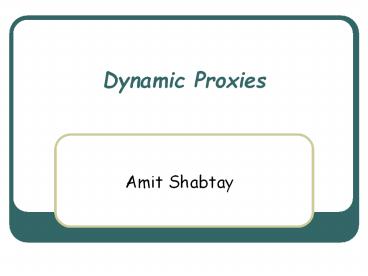Dynamic Proxies PowerPoint PPT Presentation
Title: Dynamic Proxies
1
Dynamic Proxies
- Amit Shabtay
2
Dynamic Proxies
- Main idea
- The proxy wraps objects and adds functionality.
- All proxy methods invocations are dispatched to
the invoke(...) method of the instance invocation
handler. - These methods will be handled by the proxy
instance.
3
Dynamic Proxies Scheme
The proxy also receives an invocation handler
Calling a method foo() calls invoke()
Before foo...Invoke foo()after foo...
Wrap
Create Object
Mast implement interface(s)
The heart is the invocation handler
4
Dynamic Proxies
- Support for creating classes at runtime
- Each such class implements interface(s)
- Every method call to the class will be delegated
to a handler, using reflection - The created class is a proxy for its handler
- Applications
- Aspect-Oriented Programming standard error
handling, log debug for all objects - Creating dynamic event handlers
5
Invocation Handlers
- Start by defining the handler
- interface java.lang.reflect.InvocationHandler
- With a single method
- Object invoke( // return value of call
Object proxy, // calls target Method
method, // the method called Object
args) // methods arguments - The real call made proxy.method(args)
- Simplest invoke() method.invoke(proxy,args)
6
Creating a Proxy Class
- Define the proxy interface
- interface Foo Object bar(Object obj)
- Use java.lang.reflect.Proxy static methods to
create the proxy class - Class proxyClass Proxy.getProxyClass(
- Foo.class.getClassLoader(), new Class
Foo.class ) - First argument the new classs class loader
- 2nd argument list of implemented interfaces
- The expression C.class for a class C is the
static version of C_obj.getClass()
7
Creating a Proxy Instance
- A proxy class has one constructor which takes one
argument the invocation handler - Given a proxy class, find and invoke this
constructor - Foo foo (Foo)proxyClass.
- getConstructor(new Class
InvocationHandler.class ). - newInstance(new Object new
MyInvocationHandler() )
8
- Class Proxy provides a shortcut
- Foo f (Foo) Proxy.newProxyInstance(
-
Foo.class.getClassLoader(), - new Class
Foo.class , - new
MyInvocationHandler()) - Note that all members of Class should be
interfaces only.
9
A Few More Details I
- We ignored a bunch of exceptions
- IllegalArgumentException if proxy class cant
exist - UndeclaredThrowableException if the handler
throws an exception the interface didnt declare - ClassCastException if return value type is wrong
- InvocationTargetException wraps checked
exceptions - A proxy classs name is undefined
- But begins with Proxy
- The syntax is very unreadable!
- Right, but it can be encapsulated inside the
handler
10
A Few More Details II
- Primitive types are wrapped by Integer, Boolean,
and so on for argument - This is also true for the return values.
- If null is returned for a primitive type, then a
NullPointerException will be thrown by the method
invocation.
11
A Debugging Example
- Well write an extremely generic class, that can
wrap any object and print a debug message before
and after every method call to it - Instead of a public constructor, it will have a
static factory method to encapsulate the proxy
instance creation - It will use InvocationTargetException to be
exception-neutral to the debugged object
12
A Debugging Example II
- The classs definition and construction
- public class DebugProxyimplements
java.lang.reflect.InvocationHandler - private Object obj
- public static Object newInstance(Object
obj) - return java.lang.reflect.Proxy.newProxyI
nstance( - obj.getClass().getClassLoader(
), - obj.getClass().getInterfaces()
, - new DebugProxy(obj))
- private DebugProxy(Object obj)
this.obj obj
13
A Debugging Example III
- The invoke() method
- public Object invoke(Object proxy, Method
m, Object
args) throws Throwable - Object result
- try
- System.out.println("before method "
m.getName()) - result m.invoke(obj, args)
- catch (InvocationTargetException e)
- throw e.getTargetException()
- catch (Exception e)
- throw new RuntimeException("unexpected
- e.getMessage())
- finally
- System.out.println("after method "
m.getName()) - return result
14
A Debugging Example IV
- Now that the handler is written, its very simple
to use. Just define an interface - interface Foo Object bar(Object o)
- class FooImpl implements Foo
- And wrap it with a DebugProxy
- Foo foo (Foo)DebugProxy.newInstance(new
FooImpl()) - This is not much different than using any proxy
or decorator - Just much, much slower
15
Dynamic Proxies Summary
- Applications similar to above example
- Log every exception to a file and re-throw it
- Apply an additional security policy
- Other kinds of applications exist as well
- Dynamic event listeners in Swing
- In general, being an observer to many different
objects or interfaces at once - Its a relatively new feature from JDK 1.3
- There may be other future applications
16
More Information
- http//java.sun.com/j2se/1.4.2/docs/guide/reflecti
on/proxy.html - http//java.sun.com/j2se/1.4.2/docs/api/java/lang/
reflect/Proxy.html

